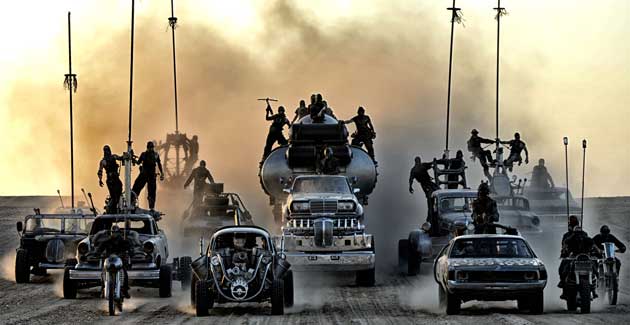
For the politerati, the 2016 presidential campaign’s No. 1 metaphor—and it has already become a cliché—is the highway lane. Pundits, political operatives, and other observers (perhaps including your aunt) have droned on about which GOP candidate inhabits which lane. There’s been talk of a tea party lane, an establishment lane, a social conservative lane, a populist lane, and so on. Now that the first three contests of the season have occurred, it’s becoming clear that there are, at most, three lanes, and, in what might be bad news for Republicans, those lanes might not merge anytime soon. In fact, there may be concrete barriers between each of them, and that increases the odds of a big, chaotic crash at the point where these lanes must converge.
Here’s the quick and easy breakdown. There is a social conservative lane, a road for the candidate fancied by the evangelical voters, the part of the GOP base that used to be called the religious right. Sen. Ted Cruz has the wheel here. Ben Carson once had a shot at this crowd and still draws some support from these quarters. But he’s faded from serious contention, and Cruz, who campaigns as a godly and courageous conservative, has the natural hold on this bunch. He hasn’t rounded up all the evangelical voters. In the South Carolina primary, 74 percent of the GOP voters said they were evangelical or born-again Christians, and Cruz drew 27 percent of that group. (Donald Trump bagged 33 percent, and Sen. Marco Rubio won over 22 percent of them.) The hard core of this group—the born-againist—will stick with Cruz and likely provide him a consistent (and perhaps persistent) base—enough to keep him in the hunt. Cruz could eventually draw many of the hanging-on Carson voters, and he also appeals to the so-called liberty voters, a ragged collection of tea partiers and libertarian-ish votes. But there’s little reason to doubt that Cruz can maintain command of this lane for the next few weeks.
Rubio has elbowed aside Jeb Bush (who?) and Gov. Chris Christie to claim the establishment lane (also known as the not-Trump-or-Cruz lane). He was elected to the Senate in 2010 as a tea partier. But in Washington, he joined pro-business GOPers to work on immigration reform and sidled up to the neocons on foreign policy, and, despite his short-time hobnobbing with party insiders in Washington and his New Hampshire robot moment, he’s the last non-Trump-or-Cruz standing in the win, place, or show ranks. The establishment has to have a horse—as do suburban Republican voters free of Trump fever and not taken by Cruz’s fundamentalism. So Rubio is in control here. Gov. John Kasich is a marginal threat to Rubio. But he’s not gaining on him this week.
The most interesting lane is Trump’s. It seems to be a lane all its own. At times, it doesn’t seem to be part of the regular GOP highway. Maybe it’s an HOV lane. Or an off-road bypass. Trump can blast away at the party elite, defend Planned Parenthood, tick off the pope, decry the Iraq War, and accuse George W. Bush of lying and call for his impeachment, and the voters in his lane—which, according to exit polls, includes a healthy mix of Republicans who say they are evangelical Christians—don’t mind at all. Like Kramer in the 150th episode of Seinfeld, Trump has repainted the lanes, and his is wide enough to include a mishmash of voters. His folks care not about the usual Republican conventions. Trump rails against the Democratic and Republican idiots of out-of-control Washington, where too much money is spent for no good reason. He denounces the trade deals GOP officials and their corporate allies relish. He points an accusing finger at big-money donors and special-interest lobbyists, asserting (as does Sen. Bernie Sanders) that the game in Washington, on Wall Street, and everywhere else is rigged. He insists he won’t let politicians gut Social Security. He wants health care of some sort—but not Obamacare!—for all. At the same time, he embraces the conservative positions on abortion and gun rights—and talks tough on China, ISIS, and just about everything. And there’s the Trump Wall and the ban on Muslims. Trump backers I have encountered at campaign events seem mostly nonideological. (In South Carolina, Trump basically did as well with Republicans who termed themselves conservative as those who said they were moderates.) Trump voters certainly are not looking for consistency. They’re mad as hell, buy his line that the country is shot to hell, and crave a politician who shares and expresses their attitudes—and who vows he will god-damn do something about it.
The Trump bloc appears to be a blend of Perot independent voters (who were attracted to the billionaire’s concern about federal spending and the national debt), Reagan Democrats (who were drawn to that conservative’s big-stick approach and racially tinged welfare-bashing), and Buchanan Republicans (who were in synch with the commentator’s right-wing populism and America-first nativism). The Trump voters don’t seem to share much in common with the voters in the other lanes. Those I’ve spoken with come across as outsiders to Republican land and people who have not been fully engaged in politics prior to the Trump campaign. Even if they have voted as Republicans in the past, they don’t think of themselves as loyal members of that tribe.
The big problem for the Republican Party is that there is not a lot of overlap between the Trump, establishment, and social conservative lanes—and, for the moment, each of the three have significant support. The party is not quite divided into equal thirds. It looks as if Trump may have a third of his own, with Cruz and Rubio each possessing between a fifth and a quarter. And the rest of the vote has been with other candidates, and some of that may now be drifting. But if these three end up the final major candidates, there’s a strong chance the race could evolve into a three-way split, or slog. Should that occur, it might be difficult for any one of them to amass a commanding lead in the delegate count.
The Republican contest could end up looking less like this:

And more like this:

But with only three souped-up vehicles, each driven by a fellow desperate to make it to the ramp at the end of the highway that only has room for one car.
Want another metaphor? Think of a trifurcated civil war. (Syria?) There are three warring factions within the GOP right now: the evangelical and purist conservatives who are looking for their Reagan or Goldwater to wage an ideological crusade, the mainline Republicans who want a draw-inside-the-lines conservative with crossover appeal who is no fiery revolutionary, and the Trumpist interlopers who have crashed the party’s gates eager to place their Cromwell on the throne. The latter group has the advantage at the moment: more early wins, better standing in the polls. With Jeb Bush recently vanquished and Kasich and Carson voters perhaps soon in play, the landscape could shift. Still, at this stage, each rival camp remains quite distinct from the others, and it is tough to see how one side finally attains majority dominance.
Back to the original metaphor: There are three cars hurtling toward a one-lane road. If none run out of gas, it won’t be pretty.









